The Green Horse section provides practical information on managing environmentally sustainable horse properties, readers stories and tips, as well as advice and articles from equestrian experts in their fields.
OCTOBER NOVEMBER 20
Vol 42 No 3
In this issue of The Green Horse you will find the following articles
WHATS EATING YOUR RUGS..and taking up residence in your food containers?
by Rhiannon Brown - Envirapest
SOLAR POWERED PRODUCTS by Celine Bønnelykke
When a complete solar system is not possible then individual solar products can still work to reduce your power consumption and costs
CALMING OUR HORSES WHILE AT HOME IN ISOLATION
by Catherine Bird for Country Park Our horses have been adjusting to us being home and spending more time with them. it is an excellent time to work on some of our riding glitches and help our horses with nervous patterns and behaviours.
MY PLACE. Wayne Kiely from Combined Horse Transport takes us on a tour of his property, Barengarra, in Central Victoria.
by Wendy Elks
WIN A YEAR'S SUBSCRIPTION...
share your equine property management tips and each issue one reader will win.
Send ideas to -
The Green Horse Support <greenhorse@hoofbeats.com.au>
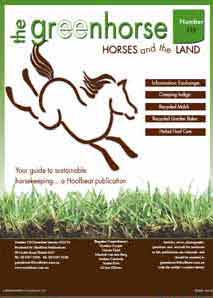

PREVIOUS ARTICLES
Available on line
Aug/Sept 20 THE HIDDEN DANGERS IN OUR PADDOCK.
by Elizabeth Tollarzo
Horses love to run, play, buck and then run again and we often, through lack of risk assessment or management practices, place them in areas that are fraught with dangers.
JUNE JULY 20 GOING SOLAR ON THE HORSE PROPERTY Where to put your panels Part 2
Once you have selected what solar system best suits your needs, then you need to look at how you can maximise the advantages.
APRIL MAY 20 GOING SOLAR ON THE HORSE PROPERTY Part 2
Once you have selected what solar system best suits your needs, then you need to look at how you can maximise the advantages.
FEB/MARCH 20 ANTS AWAY
by Mark Brown Envirapest
So, what can you do to deter ants from your house and your stables??
DJ19/20 KEEPING SNAKES OUT OF THE STABLE by Wendy Elks
Snakes may be protected under Wildlife regulations in Australia, and they may be great for keeping the mice and rats down, but do we want to find them in our stables near our horses and pets?
ON19 - TERMITES- common myths
by Rhiannon Brown, Envirapest
Your house and stables are looking wonderful this spring, but do you know what is happening inside the walls of your brick or timber building?
AS19 - OUCH THAT HURTS
by Catherine Bird for Country Park Saddlery
The extent of the swelling is usually an indication of the severity of the infection or injury and the cause needs to be established before giving herbs.
JJ19 - MANAGING PASTURE
by Rhiannon Brown, Envirapest Healthy pasture means healthy horses.
A/M19 - STOP THOSE WEEDS
Property biosecurity
by Rhiannon Brown, Envirapest
Putting simple precautionary steps into place can make it tough for weeds to get a hold on your equine paradise.
|
  
  

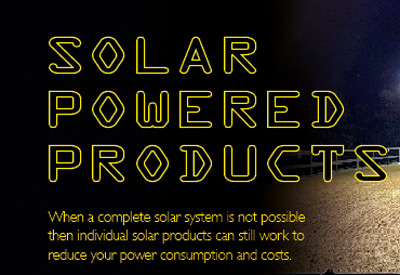
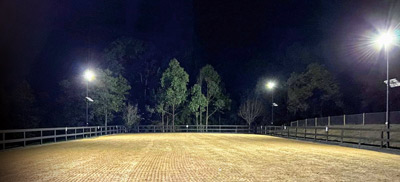
by Celine Bonnelykke
In previous issues we have discussed the economics of setting up a solar-driven property, but if finances don’t stretch to installation of the whole package, there are ways to ease into the solar-world.
SOLAR-POWERED PRODUCTS
Individual solar-powered products have become very popular and are a great way to be more conscious and sustainable in your energy usage. These have the initial cost and maintenance, the same as a full solar panel setup, but the initial outlay is less and will, over time, reduce your energy bill.
Well-known products such as solar-driven phone chargers and solar-powered garden lights are readily available but there is also a large range of options for equestrian property solar-powered products.
SOLAR ELECTRIC FENCE ENERGISERS
Solar fencing options are an easy and straightforward solution to greener energy consumption. They are also very handy if your fences are in an area where it is hard to get the mains power.
These energisers are completely independent from the mains power. Most models include an inbuilt, rechargeable battery and a charger for mains power should there be continuous poor weather conditions. Easy to set up they can power between 1km-80km of fencing!
Prices range dependent on the length of coverage, but range between $229 to $1000, and most companies offer a two or three year warranty.
Be aware of where you place your solar fence energiser, as horses can be curious and chew on anything.
Placing on a post out of reach of your horses or even surrounding it with a ‘hot’ wire, may be key to avoiding expensive repairs.
There is constant development in the area of solar appliances, especially for farming in a sunny country like Australia. Some of the options include products that weigh less than 1kg, cover up to 5km and their battery lasts 5-8 years. Be sure you select an Australian brand to support the industry and to receive a quality product, warranty and support options.
AUTOMATIC GATES
Auto-Release
If your property is set up to let your horses in and out from pasture but it is a manual exercise then there is a solar-powered solution. The Batt-Latch Gate Release Timer is specifically designed for horses, can be pre-set and will release at the given time, retracting the rope gate and allowing the horses to walk through. This ingenious device comes with its own solar panel and, apart from the convenience, it will save you time and labour and may benefit your horse’s eating and exercise habits.
Entrance Gates
The well-known solar-powered automatic gate is often used as an entrance gate, giving you security and assurance that if your horses get loose, at least they won’t be able to leave the property. The gate kit usually comes with all the components needed. Both gate solutions come with warranties and range from $500 dollars upwards, dependent on your requirements.
STABLE LIGHTS, FLOODLIGHTS AND FANS
To have lights in the stables, especially in winter, is essential, but it can be done cost- effectively using only solar energy. There are many options that can be tailored to your specific property depending on whether you want: lights in your tack area, security lights, automatic lights in individual boxes to control coat growth in winter, round yard pole light or a full arena floodlight setup.
It is important to consider where the panels for your lighting system will be placed for optimum efficiency and to avoid excess dust, especially from stables, roundyards and arenas. The batteries will last between four hours to a full day and will need replacing every 1-5 years, depending on use.
Make sure you purchase a setup with an easily accessible battery; for arena lights and other poled lights, consider a ground battery pack so you don’t have to climb.
For arena lights, you may need to have at least four poles, as shadows and ‘dark areas’ can cause some horses to spook.
And remember to place the lights at a height that is suitable for your style of riding, especially if jumping, as you don’t want the light shining right into your eyes.
Prices ranges from $300 to $1000 and can either come as a DIY kit or with installation included. A 12-month to 10-year warranty is usually provided, dependent on your setup.
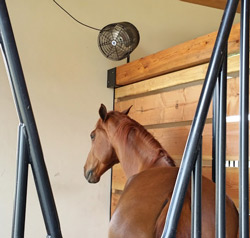
FANS AND VENTILATORS
Solar-powered fans and ventilators can be extremely pleasant during the Australian summer, both for horses and people. Fans can be a very simple and cost-effective setup, which can easily be moved: whether you are tacking up your horse or for horses stabled during summer. The air movement also helps keep flies and biting insects off your horse.
Fan costs start at $30 for a 15cm fan without backup battery.
Ventilators can be installed in the wall or ceiling of your stables or shed and will reduce temperature and humidity and improve the general air quality.
These come with a battery that can provide runtime for up to five hours for those hot summer nights if your horses are stabled. Available for as little as $250, they come with a two-year warranty provided.
IRRIGATION AND WATER PUMPS
Solar-powered irrigation and water pumps are a well-established technology that can manage your complete watering requirements on the property. Once installed there will be no further costs for electricity. Watering units consist of the panels, a pumping maximiser, the pump and cables and connectors, which means you can get water to paddocks where no mains power is available.
These units require little maintenance, but like the electric fence energisers they need to be placed out of reach of horses, fenced off and away from dusty areas.
Ranging from $1,250 to $20,000 the system can irrigate up to 50,000 litres per hour and the price can be reduced through Renewable Energy Certificates (RECs): www.energymatters.com.au/carbon-trading/
Hoofbeats reader, Kerry Long, from Cardup uses solar panels to run the irrigation at her property and says its very easy; “It doesn’t really affect my daily routine, but it certainly affects our electricity bill. There is money saved and it gives you a good conscience to use ‘clean energy’. With a large water-use to keep green grass for the horses, it is definitely worth it to think solar. We have probably halved our bill and get a small rebate back as well.”
BE ENERGY SMART
The best way to a future with sustainable energy and reduced costs is by reducing our mains usage and solar goes a long way to helping us achieve that.
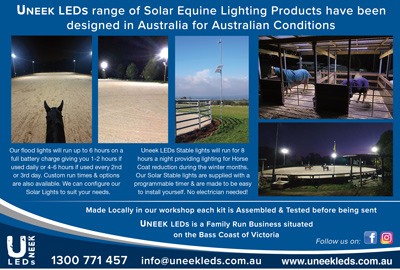
|